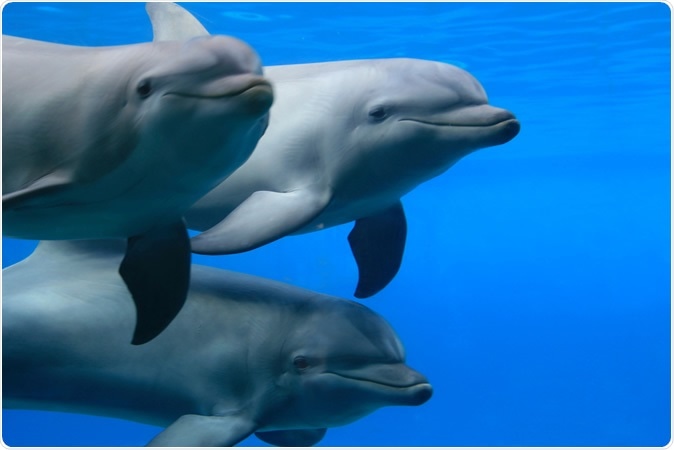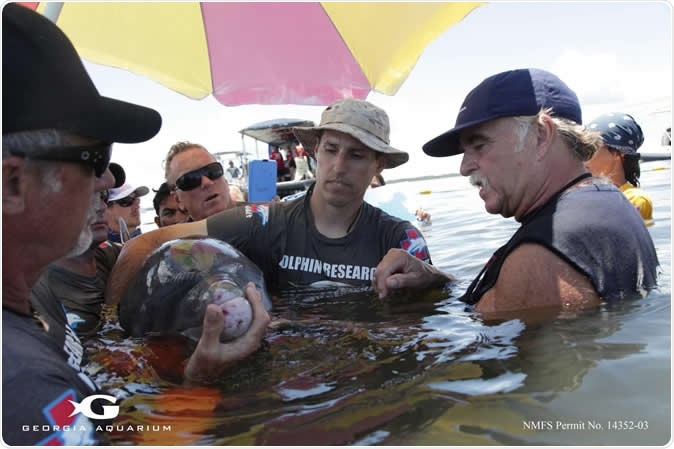Antibiotic resistance in bottlenose dolphins shows that up to 88% of pathogenic organisms in this species is resistant to one or more antibiotics. This finding offers very useful insights into the identical phenomenon in humans. This species is termed a sentinel species, which means it reflects environmental risks to humans in advance of their occurrence in humans.

Common bottlenose dolphin (Tursiops truncatus) Image Credit: R. Maximiliane / Shutterstock
Using 13 years’ worth of data collected from 171 bottlenose dolphins (Tursiops truncatus) in a river lagoon of Florida from 2003 to 2015, scientists found 733 pathogens, some of which infect humans as well. Over 88% of these were resistant to one or more antibiotics. In fact, almost 92% and 77% of organisms were resistant to erythromycin and ampicillin, respectively, which are among the most commonly used human antibiotics. Besides ampicillin and erythromycin, cephalothin is ineffective against about 62% of pathogens. Meanwhile, ciprofloxacin resistance among Escherichia coli is more than double the original level at present, just as among humans. All bacteria isolated showed significantly more resistance to ceftazidime and gentamicin over the study period.
Once upon a time, germs responded to antibiotics instantly. Then some bacteria started to show hesitant or absent responses, which was called drug resistance. First seen primarily in disease treatment centers, this has now become a global phenomenon in all kinds of environments, and especially in species that live in seawater which receives most of the run-off from human populations. About 2 million people become sick with antibiotic-resistant infections each year, which causes 23 000 deaths annually.
An early sign of adverse impact on the marine environment used in this study came in 2009. In this year the scientists reported that wild dolphins were showing antibiotic resistance to a high degree. This showed a time-related increase to the current level. The antibiotics probably came from human-occupied areas with a constant usage pattern of antibiotics. There are very few studies on how marine mammals are handling antibiotic resistant-bacteria over the long term.
The current study was based on samples collected over two periods, 2003-2007 and 2010-2015, under the Health and Environmental Risk Assessment or HERA Project. It was focused on bottlenose dolphins in Florida’s Indian River Lagoon, which has a large number of people living along the coast. It used the bacterial isolate data from the last 13 years along with the Multiple Antibiotic Resistance (MAR) index to arrive at the resistance profile. Bacterial sampling was done from the blowhole, stomach fluid, and feces. After culturing, the organisms isolated were identified and tested for antibiotic resistance.

Dr. Gregory Bossart (on the right) examines a dolphin during the Health and Environment Risk Assessment (HERA) project alongside colleagues. Image Credit: Georgia Aquarium/Addison Hill
Researcher Adam M. Schaefer says, “Based on our findings, it is likely that these isolates from dolphins originated from a source where antibiotics are regularly used, potentially entering the marine environment through human activities or discharges from terrestrial sources.” This could include discharges from septic tanks or canals, among others.
The common organisms isolated in this study included Aeromonas hydrophila, E. coli, Edwardsiella tarda, V. alginolyticus, and S. aureus, which are found in water. The highest level of resistance to Pseudomonas aeruginosa ever seen among living organisms was found in the current study, and increased over the period of 13 years covered. This bacterium causes several human infections, including respiratory and urinary infections.
The MAR index also increased significantly for Vibrio alginolyticus, a common bacterium, which is responsible for seafood poisoning, and especially for Acinetobacter baumannii, which is causing an increasing number of hospital-acquired infections over the past decade. This pathogen is becoming more and more resistant, especially in samples obtained from fish and from fish farms.
The study shows how the entry of antibiotic-resistant strains of bacteria on a large scale from human populations into the marine ecosystem is exerting selection pressure on the normal bacteria. The selected strains proliferate in an unbridled fashion, creating a population of resistant pathogens.
The study was published in the journal Aquatic Mammals on September 11, 2019.
Journal reference:
Temporal changes in antibiotic resistance among bacteria isolated from common bottlenose dolphins (Tursiops truncatus) in the Indian River Lagoon, Florida, 2003-2015. Adam M. Schaefer, Gregory D. Bossart, Tyler Harrington, Patricia A. Fair, Peter J. McCarthy, and John S. Reif. Aquatic Mammals. https://doi.org/10.1578/AM.45.5.2019.533., https://www.aquaticmammalsjournal.org/index.php?option=com_content&view=article&id=1951:isolated-from-common-bottlenose-dolphins-tursiops-truncatus-in-the-indian-river-lagoon-florida-2003-2015&catid=177&Itemid=326